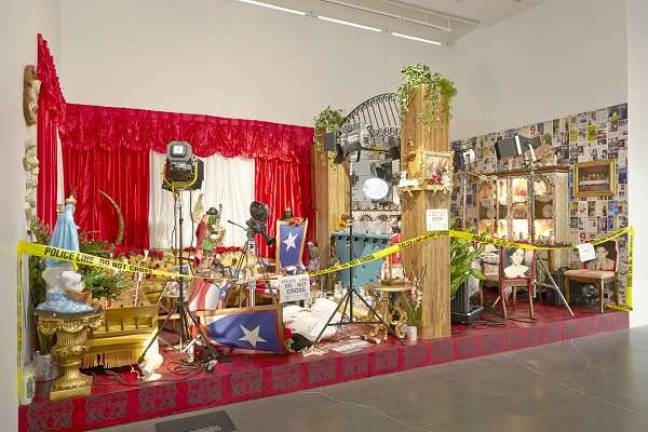Doing Time in Manhattan

The New Museum's 1993 show narrows the past
The New Museum has put together a time capsule: a collection of dozens of works produced in New York in the year 1993. If you were a teenager in 1993, the exhibit "1993: Experimental Jet Set, Trash and No Star" will probably act on you like a heady, pop blast of nostalgia. After all, some of the show's curators were themselves teenagers in 1993. The show is full of pop music and the kind of lurid imagery that goes straight to your memory banks. The result is a very warm, if perhaps incomplete, dive into the past.
The exhibit opens with a row of TV's playing snippets of news and entertainment from the time: Rudy Giuliani in an early campaign ad; Whitney Houston belting out a ballad. This sets the tone. In the same room, to make it clear that the show's focus is on the young, the curators have installed a video by Alex Brag (untitled). The piece is blurry, charming, and predictable: Barbie dolls and young women in little black dresses flail their arms to a background of Nirvana, Ace of Base, and other period music. We know where we are here.
Teenage dreamland is realized most beautifully in one large room on the museum's fourth floor. The floor is covered in a deliciously soft orange rug (Carpet, by Rudolph Stingel). Dusk-blue billboards, each with the silhouette of one bird, take up two walls, and a string of lightbulbs hangs from a rafter in the middle of the room, (both those pieces, untitled, by Felix Gonzalez-Torres). A clip of Kristin Oppenheim singing the Beach Boys' "Sail on Sailor" plays in an endless loop and completes the wistful mood.
But it's not all solitary idylls. "1993" goes heavy on death and the grotesque. The AIDS epidemic was at its peak, and the emphasis on loss is inevitable. "1993" includes a well-known, heartbreaking series of Nan Goldin photographs showing a man slowly succumbing to AIDS as his partner stands by, helpless (Gilles and Gotscho). Gregg Bordowitz's short video (Fast Trip, Long Drop) provides a vivid look at the state of the AIDS activism movement. The grotesque is harder to understand here: Why were so many artists in 1993 turning out coyly sexual life-sized dolls? Charles Ray's "Family Romance" and Paul McCarthy's "Cultural Gothic" both point to incest without, really, saying anything about it. Do we need both pieces in this show, especially after Zoe Leonard's series of anatomical models?
Maybe it's inevitable that a show of this scope will feel both incomplete and too big. After a while I, at least, found myself wandering through the rooms looking for what I already knew. The show began to repeat. Surely 1993 was about more than dysfunction in Manhattan? A few pieces in the show stand outside of time: Kiki Smith's nude, powerful Virgin Mary; Lorna Simpson's simple and somehow shattering Seven Mouths.
A few other pieces at least leave Manhattan. Pepon Osorio's The Scene of the Crime is a life-size diorama of a South Bronx apartment complete with family pictures and a woman's body under a bloody cloth. Spanish radio plays ads for detergent and the chairs are draped in Puerto Rican flags. (This Bronx murder is notably the sole mention of a borough of 1.4 million people.) And then there are, of course, Annie Liebowitz's tragic shots of Sarajevo, including one of Susan Sontag posing amidst the ruins. But why isn't there more? Did I miss something? Probably. Was the art scene too insular in 1993? Of course. Is there great work out there that still can't make it on the New Museum's Bowery? Almost definitely.
"1993: Experimental Jet Set, Trash and No Star" through May 26 at New Museum, 321 Bowery